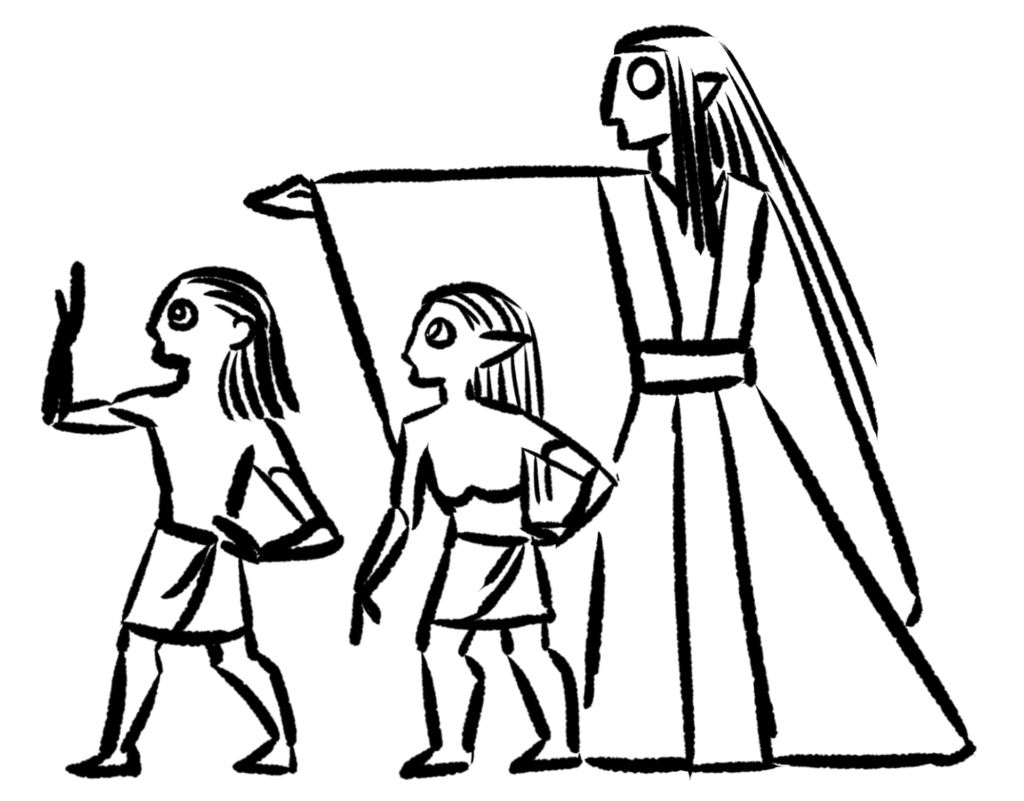The Three Elder Races
The Three Elder Races stand as the first creations of the Twins. Though the world is now full of a myriad of plants, animals, and sentient beings of every variety imaginable, in the beginning there were only three: the Humans, the Elves, and the Ancients.
Humans, the most adaptable of the three, are found in every corner of the world, though in order to survive the elemental extremes of certain regions, some populations were dramatically transformed over the generations of the First Days, and now bear little to no resemblance to what one might consider “human”. The stony plates and horns of the Stonekin or the burnished metal skin of the Ironhill people are indeed striking, and one would be forgiven for forgetting that the luminous, ocean-dwelling Sekrai were ever human. But the greatest strength of humanity is our ability to adapt to new circumstances without losing ourselves in the process. We are a hardy people with limitless potential, and the myriad peoples of the world only serve to demonstrate this strength. Humans produce the most powerful, versatile mages, and it is not uncommon for a human mage to have mastery over more than a single element – though only “unadapted” humans have ever been documented as possessing power over more than three. Perhaps the process of adapting to an environmental extreme limits the magical capabilities of that population – research is still ongoing. Regardless, humans stand as a point of balance in the world, able to shift in any direction without losing ourselves in the process.

Elves stand apart from humanity as the sky stands separate from the world. Where humans are naturally shades of earth – browns, reds, yellows – elves resemble the sky, pale shades of blue or purple studded with stars or mottled with clouds. Where humans are a roughly even balance of the six elements, elves are more strongly bent towards wind and lightning, producing a flighty, delicate people that lack the stability of humanity. Elves live longer than humans when left in peace, but struggle in times of conflict; their airy nature leaves them unsteady. Elven mages are typically weather-mages, though other varieties are simply rare and not unheard of. The elven population is smaller than humanity, and largely divided between Storm elves (elves more strongly influenced by lightning) and Wind elves (elves more influenced by wind). Storm elves are typically shorter and stockier than the tall and elegant Wind elves, and their tapered ears are also less pronounced. The skin of storm elves resembles mottled gray skies, and their hair is typically a pale yellow or blue, where the wind elves resemble clearer skies and tend towards a more purple or silvery palette. Smaller populations exist outside these categories – the elusive Dark Elves, for example, live in mountain caves and the shallowest layers of the Singing Caves, and are visually striking with their midnight skin sparkling with luminous stars. The largest single elven population is found on the Flying Islands, which were initially part of an isolated mountain chain before they were raised from the surface several centuries ago. The Islands have minimal contact or trade with the outside world, but what contact we have shows us a unique population, not so tall as the wind-elves but just as elegant, cloudless features and vibrant colors resembling a sunrise or sunset. These Cloud Elves are unique in many ways, most notably their isolationism – elves on the surface typically have no issues living alongside humans, and many humans nowadays boast traces of elven blood.

The Ancients are all but gone, but before the First Days, when the element winds were far too strong for humans or elves to survive on the surface, the Ancients were building the first cities in the deserts of Helm. The Ancients, uniquely, were completely magically inert. The element winds had no effect on them, as their souls were completely closed to the outside world. And yet, without any sort of elemental magic, they constructed vast stone edifices and spread their civilization across three continents. While we were still cowering in the caves with the elves, the Ancients had discovered how to capture elemental energy in crystalline lattices, and these primitive lacrimas, inscribed with basic commands and directives, powered vast autonomous machines, the wreckage of which are still sometimes uncovered in the desert – and as a testament to the quality of their construction, some of these machines are still somewhat operational. Regrettably, as the element winds slowly weakened and the surface gradually became habitable for elves and humans, the Ancient civilization tore itself apart in a cataclysmic civil war. When we emerged from the caves, we found only a handful of survivors among vast swaths of uninhabitable wasteland, razed by the terrible weapons the Ancients had devoted their brilliance to constructing. The Ancients are not “extinct”, but they have long since been subsumed into the population of the other two Elder Races; some humans and elves share a small amount of Ancient blood. The original Ancients were taller than any elf, with soft tan skin and pale hair – powerful giants among men, sturdy and strong. Their descendants show subtle traces of their lineage, but the glory of the Ancients is long gone.
